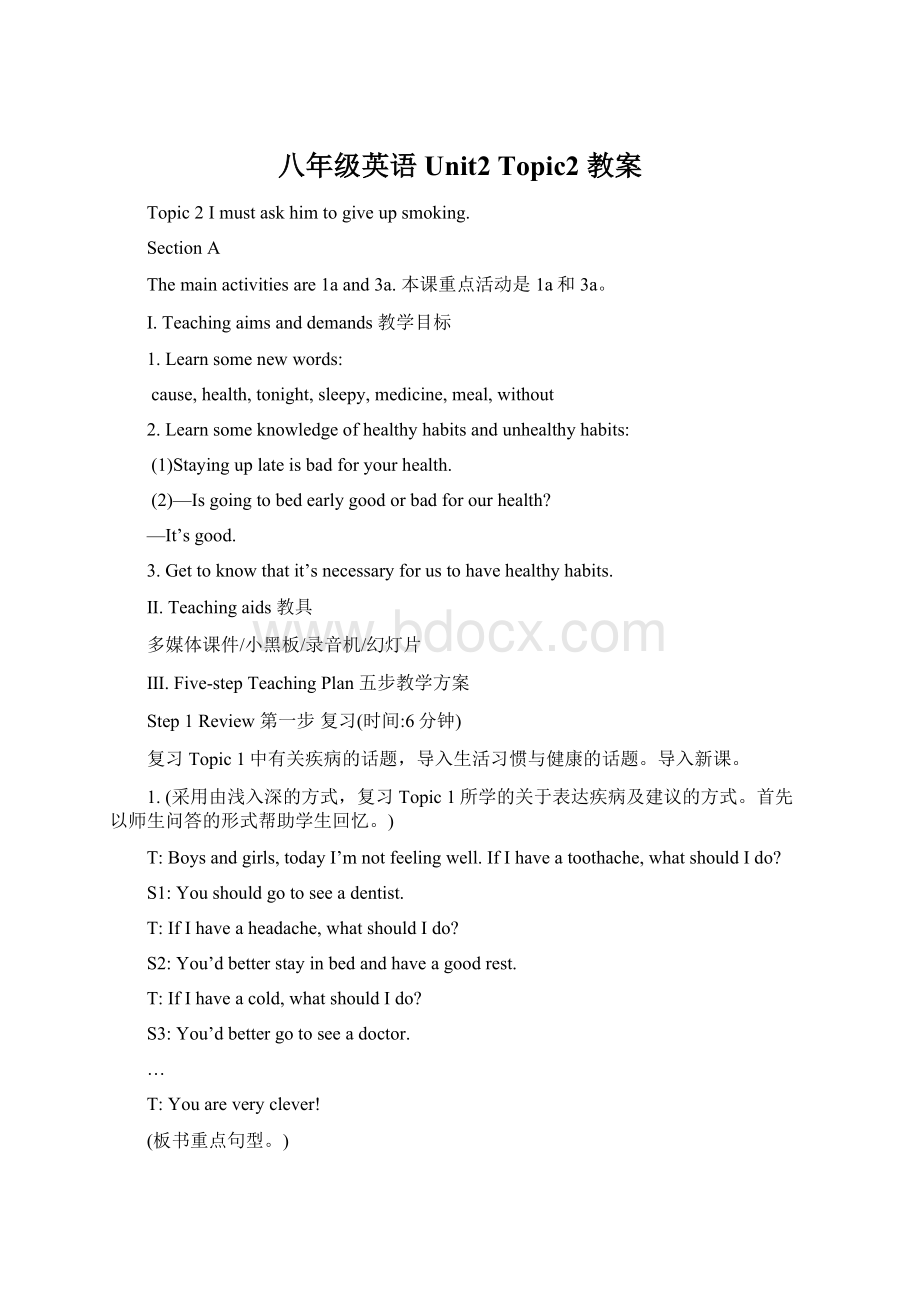八年级英语Unit2 Topic2 教案.docx
《八年级英语Unit2 Topic2 教案.docx》由会员分享,可在线阅读,更多相关《八年级英语Unit2 Topic2 教案.docx(27页珍藏版)》请在冰豆网上搜索。

八年级英语Unit2Topic2教案
Topic2Imustaskhimtogiveupsmoking.
SectionA
Themainactivitiesare1aand3a.本课重点活动是1a和3a。
Ⅰ.Teachingaimsanddemands教学目标
1.Learnsomenewwords:
cause,health,tonight,sleepy,medicine,meal,without
2.Learnsomeknowledgeofhealthyhabitsandunhealthyhabits:
(1)Stayinguplateisbadforyourhealth.
(2)—Isgoingtobedearlygoodorbadforourhealth?
—It’sgood.
3.Gettoknowthatit’snecessaryforustohavehealthyhabits.
Ⅱ.Teachingaids教具
多媒体课件/小黑板/录音机/幻灯片
Ⅲ.Five-stepTeachingPlan五步教学方案
Step1Review第一步复习(时间:
6分钟)
复习Topic1中有关疾病的话题,导入生活习惯与健康的话题。
导入新课。
1.(采用由浅入深的方式,复习Topic1所学的关于表达疾病及建议的方式。
首先以师生问答的形式帮助学生回忆。
)
T:
Boysandgirls,todayI’mnotfeelingwell.IfIhaveatoothache,whatshouldIdo?
S1:
Youshouldgotoseeadentist.
T:
IfIhaveaheadache,whatshouldIdo?
S2:
You’dbetterstayinbedandhaveagoodrest.
T:
IfIhaveacold,whatshouldIdo?
S3:
You’dbettergotoseeadoctor.
…
T:
Youareveryclever!
(板书重点句型。
)
IfIhavea
whatshouldIdo?
toothache
headache
cold
…
Youshould/shouldn’t…/You’dbetter(not)…/Whynot…?
(通过问题的进一步深入,引导学生说出更多的建议方式,最后由学生以对话形式表演出以上疾病和建议内容。
)
2.(由疾病话题,谈及如何保持健康,再过渡到生活习惯。
通过调查几个学生的生活习惯,导入本话题。
)
T:
Whenweareill,wefeelterrible.Sohealthisveryimportant.Ifwehavegoodliving
habits,wewillbeingoodhealth.Doyouthinkso?
Ss:
Yeah!
(板书,让学生猜测词义并要求学生掌握。
)
health
T:
NowIwillmakeasurveyaboutyourlivinghabits.Wouldyoumindanswering?
Ss:
Ofcoursenot.
T:
Doyoubrushyourteetheveryday?
S4:
Yes.
T:
Isitagoodorbadlivinghabit,boysandgirls?
Ss:
It’sagoodhabit.
T:
Yes,it’sgoodforourhealth.Inthislesson,let’stalkmoreaboutlivinghabitsanddiscusswhicharebadandwhicharegood.
Step2Presentation第二步呈现(时间:
11分钟)
继续调查学生的生活习惯,引出1a中有关表达生活习惯与健康的词汇和短语。
培养学生的听说能力。
1.(找同学回答问题。
)
T:
Doyouusuallygotobedlate?
S1:
No,Idon’t.
T:
Verygood.It’sgoodforyourhealth.
T:
S2,whatdoyouusuallydobeforegoingtobed?
S2:
Iusuallyplaycomputergames.
T:
Doyoualwaysdothatverylate?
S2:
Yes,Ido.Ilikeitverymuch.
T:
Doyoufeelsleepynextday?
S2:
Yes,Ido.
T:
Oh,it’stoobad.Ithinkstayinguplatecausedyoutofeelsleepy.Itisbadforyourhealth.
(解释stayuplate这个词组。
)
T:
Whenareyougoingtobedtonight,S2?
(板书要求掌握。
)
cause,sleepy,tonight
S2:
I’mgoingtobedatninetonight.
T:
Good.It’sgoodforyourhealth.
2.(通过图片展示一些生活习惯。
然后让学生判断图片上表示的习惯是否有益健康。
)
(教师可利用多媒体出示
(1)一个学生晨跑的画面。
(2)一男孩不洗手就吃饭的画面。
(3)一男孩吃饭囫囵吞枣的画面。
(4)一男孩抽烟的画面。
(5)一个学生早上做早操的画面。
如果没有多媒体,教师可以直接表演动作或用出示图片的方式来导入。
)
Picture1Picture2Picture3Picture4Picture5
T:
Let’slookatthescreen.(ShowPicture1)Isitgoodforyourhealth?
Ss:
Yes,itis.
T:
(ShowPicture2)Isitgoodorbadforyourhealth?
Ss:
It’sbad.
…
3.(由生活习惯切入到主人公Kangkang的问题上来,设置听力任务。
听1a录音。
)
T:
Today,ourfriend,Kangkang,lookstired.What’swrongwithhim?
Now,pleaselistentothetapeandfindouttheanswers.
(教师用多媒体或小黑板出示课前准备好的问题。
)
(1)What’swrongwithKangkangtoday?
Why?
(2)WhatadvicedoesJanegiveKangkang?
(核对答案。
)
4.(让学生跟读1a,并找出关键词。
)
T:
Nowopenyourbooks.Read1aafterthetapeandfindoutthekeywordsinthedialog.
(可让学生举手发言回答问题,也可抢答。
教师板书关键词,为学生下一步自由表演做准备。
)
(板书)
looktired,headache,soccergame,stayup,late,bebadfor…,feelbetter,tonight
Step3Consolidation第三步巩固(时间:
8分钟)
完成1b。
通过表演,复述等活动,进一步巩固和强化对1a的理解。
1.(可让学生看1b的例子,两人一组完成1b。
)
2.(让学生根据板书的关键词,用自己的语言表演1a对话。
巩固1a中呈现的重要短语。
)
T:
Nowpleasepracticeandactthedialogoutinpairs,usingthekeywordsontheblackboard.
(教师走到学生中间指导。
几分钟后,找两个同学到讲台前来表演。
)
…
T:
Welldone!
3.(在表演的基础上,教师对1a中主人公Kangkang的问题提问,学生回答,进一步强化对1a的理解。
)
T:
Nowlet’stalkaboutthestorytogether.WhatcausedKangkang’sproblem?
S1,please.
(必要时,可用汉语解释本句。
)
S1:
HewatchedasoccergameonTVlastnight.Hewenttobedverylate.
T:
Sohedidn’tgetenoughsleep.What’sKangkang’sfeelingnow?
Ss:
Kangkangistiredandhasaheadache.
T:
Yes.BecauseKangkangdidn’tgetenoughsleep,heistiredandhasaheadache.Thenwhat’sJane’sadviceforKangkang,S2?
S2:
Janethinksstayinguplateisbadforhishealth.SheasksKangkangtogotobedearlytonight.
T:
Youareveryclever.IsKangkanggoingtobedearlytonight?
Ss:
Yes,heis.
T:
Verygood.
4.(让学生自编对话,巩固1a对话中所呈现的内容。
)
T:
Next,makeadialogaccordingto1aandtheexamplein1b.
Step4Practice第四步练习(时间:
10分钟)
通过听、说、读、写等形式的活动,进一步练习和扩展关于生活习惯的词汇及短语,并学习应用选择疑问句来判断生活习惯与健康的关系,引导学生养成良好的生活习惯。
完成2,3a,3b和4。
1.(听关于王俊峰的生活事例的录音,进一步练习关于生活习惯的一些短语,放2录音,完成2。
)
T:
Next,we’lllearnsomethingaboutWangJunfeng.Pleaselookat2onPage33.Gothroughthephrasesin2.Thenlistenandcheck(√).WhydidWangJunfenggetaheadache?
Shouldhetakesomemedicine?
(核对答案。
)
(板书并要求掌握。
)
medicine
2.(通过教学3a中关于生活习惯的词汇及短语,让学生通过辨别其中习惯的好坏,养成良好的生活习惯。
)
T:
Well,weknowWangJunfeng’shabitsar